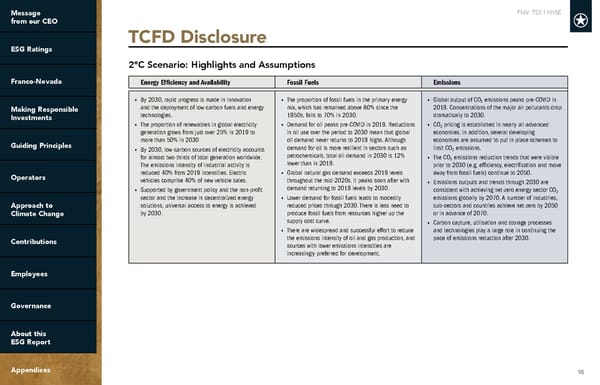FNV: TSX | NYSE 98 TCFD Disclosure 2°C Scenario: Highlights and Assumptions Energy Efficiency and Availability Fossil Fuels Emissions • By 2030, rapid progress is made in innovation and the deployment of low-carbon fuels and energy technologies. • The proportion of renewables in global electricity generation grows from just over 25% in 2019 to more than 50% in 2030 • By 2030, low-carbon sources of electricity accounts for almost two-thirds of total generation worldwide. The emissions intensity of industrial activity is reduced 40% from 2019 intensities. Electric vehicles comprise 40% of new vehicle sales. • Supported by government policy and the non-profit sector and the increase in decentralized energy solutions, universal access to energy is achieved by 2030. • The proportion of fossil fuels in the primary energy mix, which has remained above 80% since the 1950s, falls to 70% in 2030. • Demand for oil peaks pre-COVID in 2019. Reductions in oil use over the period to 2030 mean that global oil demand never returns to 2019 highs. Although demand for oil is more resilient in sectors such as petrochemicals, total oil demand in 2030 is 12% lower than in 2019. • Global natural gas demand exceeds 2019 levels throughout the mid-2020s. It peaks soon after with demand returning to 2019 levels by 2030. • Lower demand for fossil fuels leads to modestly reduced prices through 2030. There is less need to produce fossil fuels from resources higher up the supply cost curve. • There are widespread and successful effort to reduce the emissions intensity of oil and gas production, and sources with lower emissions intensities are increasingly preferred for development. • Global output of CO 2 emissions peaks pre-COVID in 2019. Concentrations of the major air pollutants drop dramatically to 2030. • CO 2 pricing is established in nearly all advanced economies. In addition, several developing economies are assumed to put in place schemes to limit CO 2 emissions. • The CO 2 emissions reduction trends that were visible prior to 2030 (e.g. efficiency, electrification and move away from fossil fuels) continue to 2050. • Emissions outputs and trends through 2030 are consistent with achieving net-zero energy sector CO 2 emissions globally by 2070. A number of industries, sub-sectors and countries achieve net-zero by 2050 or in advance of 2070. • Carbon capture, utilisation and storage processes and technologies play a large role in continuing the pace of emissions reduction after 2030.
 Simple Demo Page 97 Page 99
Simple Demo Page 97 Page 99